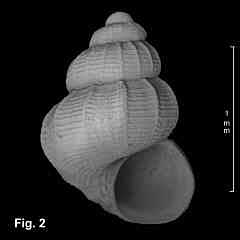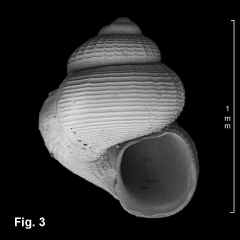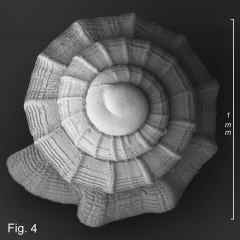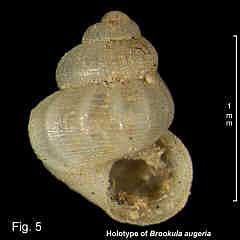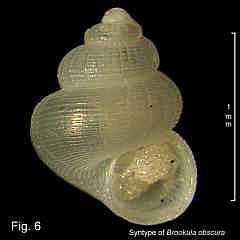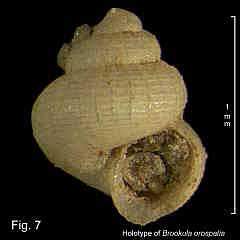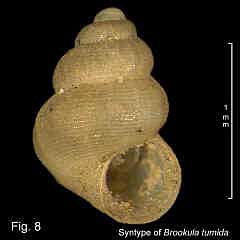|
|
|
|
|
Brookula angeli (Tenison-Woods, 1877) Description: Shell minute, height to width ratio variable in range 1.1-1.4. Protoconch smooth. Teleoconch up to 3 rounded whorls, suture deep. Sculpture very variable; teleoconch initially with fine, cancellate pattern of crisp axial threads and weaker spiral threads at closer spacing; spiral threads usually persist on remaining whorls, or rarely, fade out; axial threads on remaining whorls variable in strength from absent to strong, becoming more widely spaced. Often strong axial folds on last half whorl, regardless of other sculpture. Umbilicus narrowly to moderately open. Aperture circular, margin entire, not thickened. Shell colourless translucent when fresh, becoming opaque white with age. Size: Up to 1.4 mm in length. Distribution: Endemic to Australia: Caloundra, Queensland, southwards to SA, including Tasmania. Habitat: Known from beach washup and down to 384 m. Common. Comparison: Species of the genus Brookula can be differentiated thus: B. nepeanensis is the tallest in the genus, with the umbilicus closed or nearly so, with strong, crisp ribs on all whorls, and a fairly constant rib count. B. angeli is by far the most common. It is not quite as tall as B. nepeanensis, has the umbilicus narrowly to moderately open, and has unique but variable sculpture. B. crebresculpta is relatively squat, with numerous axial ribs, and the umbilicus moderately to widely open. B. finesia is similar to B. crebrisculpta is shape, and in having many axial ribs. But B. finesia is larger, (maximum length 1.6 mm as opposed to 1.1 mm), the axial ribs are high, and the umbilicus is wide and open. B. denselaminata is relatively low and wide, with numerous axial ribs and a widely open umbilicus. Synonymy: Laseron (1954), did not recognise the extent of sculptural variability in this species, and described the various forms as separate species. Brookula obscura Laseron, 1954 (Fig. 6) has weak axial sculpture (NEW SYNONYM). Brookula augeria Laseron, 1954 (Fig. 5) has strong axial ribs (NEW SYNONYM). Brookula orospatia Laseron, 1954 (Fig. 7) has axial ribs intermediate in strength (NEW SYNONYM). Brookula tumida Laseron, 1954 (Fig. 8) is similar to B. obscura but has a more elongate shell (NEW SYNONYM). Remarks: This is by far the most common species of the genus found in beach washup and shallow water in NSW. It is variable in the strength of the axial and spiral sculpture, but is identified by the crisp, reticulate pattern of threads on the initial teleoconch whorls. One peculiar feature is the development of a few strong axial folds on the last half of the last whorl (i.e. the dorsal surface), much stronger than the other axial ribs. This occurs in many but not all shells, even in those otherwise weakly sculptured. Fig. 1: Off Eden, NSW (C.215090) Fig. 2: Off Port Davey, Tasmania, in 132 m (C.462813) (Photo Sue Lindsay, Australian Museum) Fig. 3: Eden Harbour, NSW (C.462815) (Photo Sue Lindsay, Australian Museum) Fig. 4: Off Port Davey, Tasmania, in 132 m (C.462813) (Same specimen as Fig. 2) (Photo Sue Lindsay, Australian Museum) Fig. 5: HOLOTYPE of Brookula augeria. Off Twofold Bay, NSW, 73-91 m (C.102817) Fig. 6: SYNTYPE of Brookula obscura. Port Stephens, NSW, shell sand (C.102820) Fig. 7: HOLOTYPE of Brookula orospatia. Off Twofold Bay, NSW, 73-91 m (C.102821) Fig. 8: SYNTYPE of Brookula tumida. Off Twofold Bay, NSW, 73-91 m (C.102816) |

